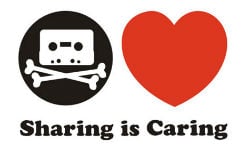 Last month, research from the Columbia University affiliated American Assembly found that U.S. file-sharers buy 30% more music than their non-sharing counterparts.
Last month, research from the Columbia University affiliated American Assembly found that U.S. file-sharers buy 30% more music than their non-sharing counterparts.
The RIAA wasn’t too happy with this result (or how the media reported on it) so they brought in research firm NPD to counter with some statistics of their own. According to NPD’s Russ Crupnick the result could be explained by a myriad of third variables.
Yesterday, Joshua Friedlander, RIAA’s Vice President of Research and Strategic Analysis, followed up on the topic, assuring readers that music pirates certainly don’t buy more music because they download music illegally.
“Some commentary has misleadingly reported that people who use P2P services like BitTorrent buy more music than non-users, implying that there’s some sort of causation,” he writes.
According to the RIAA there is a very simple explanation for the finding that file-sharing music consumers buy more music – they are simply more interested in music than average music consumers (to begin with).
“In reality, the comparison is unfair – what it’s comparing is people who are interested in music with people who might not be interested at all. Of course people interested in music buy more,” Friedlander writes.
Eh..?
So the RIAA is now arguing that among music consumers, P2P users are more interested in music than non-sharers?
It seems so, as the RIAA backs up this (for them) unusual conclusion by linking to data from NPD who found that among 18-35 year-olds, music buying P2P users spend 40% more than those who don’t share at all. In 2011 music pirates spent $267 per capita compared to $191 for those who don’t share.

“What it says is that the people who download music illegally are generally more engaged in music, so they go to shows and they wear their favorite artists on their shirts,” is NPD’s conclusion from these stats.
An interesting conclusion, and exactly the same as ours when we reported on the study.
“A likely explanation for these results is that true music enthusiasts simply want to consume, sample and discover as much new music as they possibly can, and the most straightforward and convenient way to do this is through file-sharing networks,” we wrote at the time.
So we all agree, at least on this part.
Opinions differ greatly on the direction of the link between engagement and file-sharing. NPD and the RIAA see it exclusively as a one way street. They believe it’s silly to argue that some people visit more concerts because they discovered artists through sharing, for example.
“Are we saying that P2P file sharing promotes T-shirt sales, or show attendance? Of course not; that would be silly,” NPD’s Russ Crupnick writes.
But is it really that silly? Or is it possible that some file-sharers become more engaged music fans because they have access to music they wouldn’t be able to afford otherwise? Could it be that these file-sharers then visit a concert of a band they wouldn’t have known if they didn’t pirate?
In a “misleading” twist of its own NPD points out that piracy must be the reason for the decline in revenue because the average P2P user (non music buyers included) now spends $42 per capita on music compared to $90 in 2004. What they fail to notice, however, is that P2P users are mostly sharing video now. So the percentage of music buyers among P2P users is much lower than before, which makes it a flawed comparison.
But whatever the case is, it might not be smart to label all music pirates as “thieves” without looking carefully at the reasons why they use file-sharing networks. After all, these people are also the music industry’s most engaged customers, and there’s nothing misleading about that.
Update: Micheal Geist points out that NPD made a HUGE mistake in their table. They actually added the subtotal to the total count. Who’s drinking now?





